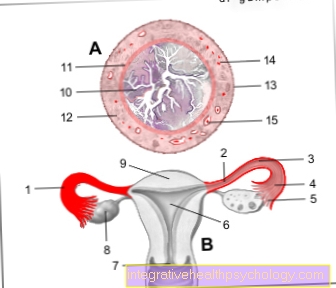Hepatitis C vaccination
introduction
There is currently no vaccine available against the virus. To protect against infection with the hepatitis C virus (HCV), the Standing Vaccination Commission (STIKO) of the Robert Koch Institute recommends numerous preventive measures.
Approximately 150 million people worldwide are infected with HCV. The virus is often transmitted through the blood (e.g. through reused injection needles in drug addicts, needle stick injuries in medicine or blood transfusions). In addition, in rare cases, the virus can also be transmitted from mother to child during childbirth as well as sexual transmission.
Read more on the topic: Hepatitis C.

Why is there no hepatitis C vaccination?
The hepatitis C virus is characterized by very rapid growth. Numerous mutations occur from generation to generation, which differentiate the individual viruses from one another. An inaccurately working enzyme within the virus, the RNA polymerase, is responsible for the occurrence of the mutations. Overall, a distinction is made between 7 main types of the hepatitis C virus, which in turn can be subdivided into numerous subgroups (subtypes).
With active vaccination, killed or weakened pathogens are injected into the patient, whereupon the immune system forms antibodies against the protein structures on the surface. In the event of an infection with hepatitis C viruses, the immune system would be prepared and could fight the invading viruses directly with the antibodies already present. Due to the high mutation rate of the viruses, the hepatitis C viruses have altered protein structures on the surface, which is why the immune system cannot fight the viruses immediately. For this reason, the development of a vaccination against hepatitis C virus is proving difficult and vaccination is not possible at this point in time.
Also read our topic: Symptoms of hepatitis C.
How else can you protect yourself against hepatitis C?
The Standing Vaccination Commission (STIKO) of the Robert Koch Institute recommends numerous preventive measures to protect against infection with hepatitis C viruses. These have already led to a decrease in the annual HCV infections in Germany.
The risk of HCV infection is particularly high among medical staff. The STIKO therefore advises numerous hygiene measures and protection against needle stick injuries. This includes wearing double gloves for surgical or invasive interventions, the use of suitable instruments and the use of protective clothing. In addition, all medical staff is examined for the HCV status before starting their work and at regular intervals.
To protect against transmission of HCV through blood products (blood transfusions, organ transplants), all blood products have been checked for HCV since 1991. As a result, the risk of a transfusion-associated HCV infection has significantly decreased and is currently less than 1: 3,000,000.
Finally, the STIKO also advises special measures to be taken when a child is born to an HCV-positive mother. Although the overall risk of HCV transmission at birth is rather low, diagnostic interventions before birth should be avoided and, if necessary, a caesarean section should be carried out if birth injuries or multiple births are expected.
Read more on the topic: Hepatitis C - mode of transmission and infection
Is a hepatitis C vaccination in prospect?
In recent years, a great deal of research has been carried out to develop a vaccine against hepatitis C.
Many data have shown that an HCV vaccination is possible in principle. However, developing a suitable vaccine remains difficult. Research is often carried out into the development of so-called combination vaccines, which consist of at least two different vaccines and are effective against a large number of viruses. Individual vaccines are already in the clinical testing phase and show promising results so far. However, it will likely be several years before a commonly used vaccine is developed.
What form of hepatitis can you get vaccinated against?
While vaccination against hepatitis C is not possible, vaccines are available for hepatitis A and hepatitis B.
A vaccination against hepatitis A virus is recommended by the STIKO for all people at risk. These include medical personnel and people working in the food industry. In addition, vaccination against hepatitis A is also recommended for patients with an increased risk of the disease (e.g. patients with chronic liver disease). Finally, the STIKO recommends vaccination even when traveling to areas with a high frequency of illness. These include mainly subtropical and tropical areas in Africa, South America and Southeast Asia. The vaccine is a dead vaccine (inactivated hepatitis A virus) that is injected twice every 6 to 12 months.
A vaccination against hepatitis B viruses is generally recommended by the STIKO for everyone in infancy or childhood. In addition, medical personnel in particular should be vaccinated against hepatitis B viruses. The vaccine is also a dead vaccine (inactivated hepatitis B virus), which is injected three to four times during the first year of life. A booster vaccination is usually not required.
You may also be interested in this topic: Vaccination against hepatitis B





























